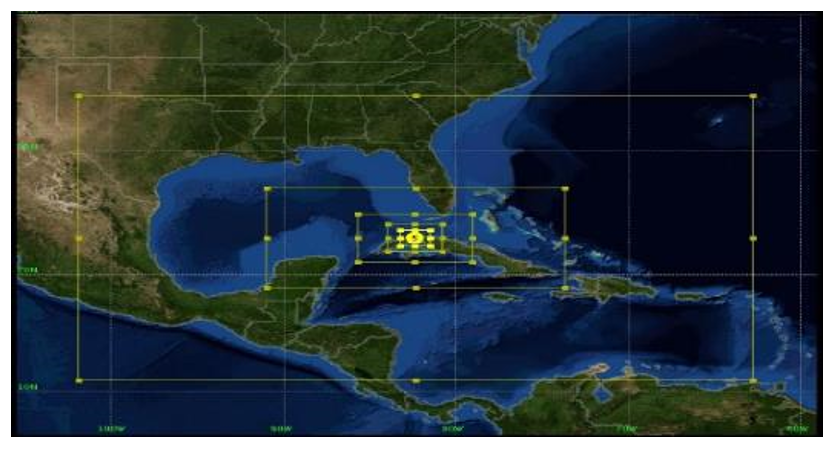Estudio físico-numérico de la línea prefrontal que afectó a La Habana el 27 de enero de 2019
Contenido principal del artículo
Resumen
Se realizó una simulación numérica con el modelo WRF para el día 27 de enero de 2019 con el objetivo de evaluar los factores físico-dinámicos que ocasionaron la formación de vórtices en la línea prefrontal, así como las causas de la fuerte racha reportada en la estación de Casablanca al paso de este sistema. Se encontró, a partir de la simulación, que la inestabilidad por cizalladura horizontal fue la desencadenante de los vórtices por delante del frente, de los cuales uno posteriormente fue desarrollado por una corriente ascendente convectiva. Se encontró la presencia de una corriente de entrada trasera que provocó la formación del eco en arco observado, el desarrollo del vórtice y vientos en superficie de categoría EF0 en la escala de Fujita mejorada.
Descargas
Detalles del artículo

Esta obra está bajo licencia internacional Creative Commons Reconocimiento-NoComercial 4.0.
Aquellos autores/as que tengan publicaciones con esta revista, aceptan los términos siguientes de la Licencia CC Reconocimiento-NoComercial 4.0 Internacional (CC BY-NC 4.0):
Usted es libre de:
- Compartir — copiar y redistribuir el material en cualquier medio o formato
- Adaptar — remezclar, transformar y crear a partir del material
El licenciador no puede revocar estas libertades mientras cumpla con los términos de la licencia.
Bajo las condiciones siguientes:
- Reconocimiento — Debe reconocer adecuadamente la autoría, proporcionar un enlace a la licencia e indicar si se han realizado cambios. Puede hacerlo de cualquier manera razonable, pero no de una manera que sugiera que tiene el apoyo del licenciador o lo recibe por el uso que hace.
- NoComercial — No puede utilizar el material para una finalidad comercial.
- No hay restricciones adicionales — No puede aplicar términos legales o medidas tecnológicas que legalmente restrinjan realizar aquello que la licencia permite.
La revista no se responsabiliza con las opiniones y conceptos emitidos en los trabajos, son de exclusiva responsabilidad de los autores. El Editor, con la asistencia del Comité de Editorial, se reserva el derecho de sugerir o solicitar modificaciones aconsejables o necesarias. Son aceptados para publicar trabajos científico originales, resultados de investigaciones de interés que no hayan sido publicados ni enviados a otra revista para ese mismo fin.
La mención de marcas comerciales de equipos, instrumentos o materiales específicos obedece a propósitos de identificación, no existiendo ningún compromiso promocional con relación a los mismos, ni por los autores ni por el editor.
Citas
Atkins, N. T., and M. St. Laurent, 2009: Bow Echo Mesovortices. Part II: Their Genesis. Mon. Wea. Rev., 137,1514–1532, https://doi.org/10.1175/2008MWR2650.1.
Carbone, R. E., 1982: A Severe Frontal Rainband. Part I. Stormwide Hydrodynamic Structure.J.Atmos.Sci.,39,258–279,https://doi.org/10.1175/1520-0469(1982)039<0258:ASFRPI>2.0.CO;2.
Clark MR, Parker DJ. Synoptic-scale and mesoscale controls for tornadogenesis on cold fronts: A generalised measure of tornado risk and identification of synoptic types. Q J R Meteorol Soc. 2020; 146: 4195–4225. https://doi.org/10.1002/qj.3898
Conrad, D. M., and K. R. Knupp, 2019: Doppler Radar Observations of Horizontal Shearing Instability in Quasi-Linear Convective Systems. Mon. Wea. Rev., 147, 1297–1318, https://doi.org/10.1175/MWR-D-18-0257.1.
Fjørtoft, R., 1950: Application of integral theorems in deriving criteria of stability for laminar flows and for the baroclinic circular vortex. Geofys. Publ., 17, 52.
Fujita, T. T., 1981: Tornadoes and downbursts in the context of gener-alized planetary scales. J. Atmos. Sci., 38, 1511–1534, doi:10.1175/1520-0469(1981)038 , 1511:TADITC . 2.0.CO;2.
Haurwitz, B., 1949: the Instability of Wind Discontinuities and Shear Zones in Planetary Atmospheres. J. Meteor., 6, 200–206, 10.1175/1520 0469(1949)006<0200:TIOWDA>2.0.CO;2
Helmus, J.J. & Collis, S.M., (2016). The Python ARM Radar Toolkit (Py-ART), a Library for Working with Weather Radar Data in the Python Programming Language. Journal of Open Research Software. 4(1), p.e25. DOI: http://doi.org/10.5334/jors.119
Investigating Vortexgenesis from Quasi-Linear Convective Systems in the United Kingdom Buckingham, T. (Author). 31 Dec 2022. Student thesis: Phd
Lee, B. D., and R. B. Wilhelmson, 1997: The Numerical Simulation of Nonsupercell Tornadogenesis. Part II: Evolution of a Family of Tornadoes along a Weak Outflow Boundary. J. Atmos. Sci., 54, 2387–2415, https://doi.org/10.1175/1520-0469(1997)054<2387:TNSONT>2.0.CO;2.
Okubo, A., 1970: Horizontal dispersion of fl oatable particles in the vicinity of velocity singularities such as convergences. Deep-Sea Res., 17, 445–454, https://doi.org10.1016/0011-7471(70)90059-8.
Orlanski, I. (1975). A rational subdivision of scales for atmospheric processes. Bull.Amer. Meteorol. Soc., 56 (5), 527–530 pp.
Rayleigh, L. (1879), On the Stability, or Instability, of certain Fluid Motions. Proceedings of the London Mathematical Society, s1-11: 57-72. https://doi.org/10.1112/plms/s1-11.1.57
Skamarock, W. C., Klemp, J. B., Dudhia, J., Gill, D. O., Barker, D., Duda, M. G., … Powers, J. G. (2008). A Description of the Advanced Research WRF Version 3 (No. NCAR/TN-475+STR). University Corporation for Atmospheric Research. http://dx.doi.org/10.5065/D68S4MVH
Smull, B. F., and R. A. Houze, 1987: Rear Inflow in Squall Lines with Trailing Stratiform Precipitation. Mon. Wea. Rev., 115, 2869–2889, https://doi.org/10.1175/1520-0493(1987)115<2869:RIISLW>2.0.CO;2.
Trapp, R. J., and M. L. Weisman, 2003: Low-Level Mesovortices within Squall Lines and Bow Echoes. Part II: Their Genesis and Implications. Mon. Wea. Rev., 131, 2804–2823, https://doi.org/10.1175/1520-0493(2003)131<2804:LMWSLA>2.0.CO;2.
Weiss, J., 1991: The dynamics of enstrophy transfer in two-dimensional hydrodynamics. Physica D, 48, 273–294, https://doi.org/10.1016/0167-2789(91)90088-Q.

